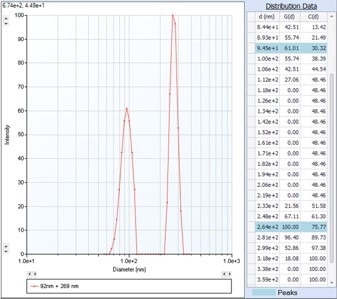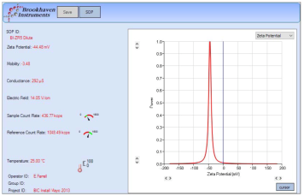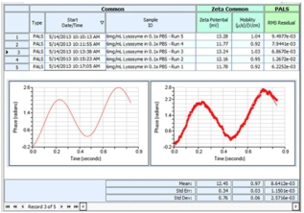Omni is the most comprehensive particle size and zeta potential instrument offered from the NanoBrook family of analyzers. The Omni offers multiple powerful particle characterization techniques. The Omni also offers the ability to measure zeta potential by either Electrophoretic Light Scattering (ELS) or Phase Analysis Light Scattering (PALS). The also offers Dynamic Light Scattering (DLS) that is used for fast, routine, submicron measurements in research and quality control applications. All Nanobrook particle sizing instruments offer a 90 degree detection angle. The Omni offers additional forward scattering at 15 degrees and backscatter at173 degrees.
Measurements of colloids are traditionally made using a 90° scattering angle. For smaller nanoparticles, proteins including IgG, mAbs, and peptides, these < 50 nm samples can be measured using the backscattering angle (173°) while the 15° detection angle can be selected for added sensitivity with aggregation measurements.
The technologies built-in our DLS instrumentation were developed by world-renowned researchers in particle characterization that did their post-doc at Stony Brook University. The designed the Omni with a superior optical plate that utilizes state-of-the-art optics, powerful 40 mW solid state laser, and highly sensitive Avalanche Photodiode Detector (APD). At the heart of the Omni particle sizer is the digital correlator for the auto correlation function that is used to calculate effective diameter and Polydispersity Index (PDI). The Brookhaven Instruments correlators were developed by Dr. Walther Tscharnuter, who was the original innovator of the digital correlator used in todays instrumentation.
The Omni analyzer is perfect for rapid, routine sizing applications in quality control and research. It is a fast and precise method for characterizing protein and nanoparticle size distributions.
Particle Sizing Features
•Wide range of particle size from <0.3 nm to 10 µm
•40 mW temperature controlled, solid-state laser diode with APD detector collecting signal from a 15o, 90°, or 173o scatter
•Peltier temperature control from −5 °C to 110 °C with nitrogen gas connection to prevent condensation
•TurboCorr digital correlator that is 100% efficient, real-time operation over the full delay time range
•Data from correlator and count rate history can be viewed in their raw, unprocessed, unsmoothed form
•Dust filter to reject data that is corrupted by scattering from dust
•Automatic baseline index determination along with option for calculation at infinite delay time
•Conforms to ISO 2241 and ISO 13321 standards
NanoBrook 90Plus particle autocorrelation function displays data in graphical form the decay rate and baseline. The average effective diameter (Eff. Dia.) and Polydispersity (PDI), a measure of the distribution width, are displayed.

Multimodal size distributions can be determined. A numerical algorithm, including Mie theory, can be used.
During a measurement, the display can be switched interactively between any one of these — correlation function, lognormal, or multimodal — each shown “live” as data are accumulated.
The Omni offers the ability to measure zeta potential by either ELS or PALS. The PALS methods was developed based theories formulated at Bristol University and introduced into the market by Brookhaven Instruments. The PALS method is a 1000 times more sensitive than traditional light scattering techniques based on the shifted frequency spectrum. With the PALS method, a particle only needs to move a fraction of its’ own diameter ,making this method ideal for samples that have a very low mobility. Low mobility can be the result of particles dispersed in oily or unusually viscous media, weakly charged samples near their isoelectric points, or samples in which a field strength of 1-2 V/cm can be generated.
Both ELS and PALS methods for zeta potential measurements use a specialized palladium based electrode in which an alternating voltage is applied that causes the particles of one charge to move towards the electrode of the opposite charge. The velocity of the movement is determined by forward light scattering collected at 15o angle. Typically, the higher the velocity the greater the charge of the particle.
The PALS method is a versatile technique that does not require the application of large electric fields which may result in unwanted sample heating or degradation. The PALS method can be used with particles in a solution that has a high ionic concentration (up to 3M) or sample conductivity of up to 220mS/cm. The high salt tolerance of the PALS method makes it ideal for samples prepared at physiological ionic strength such as with a phosphate buffer solution(PBS).
Electrophoretic Light Scattering (ELS) Features
•Zeta potential measured with high accuracy in low salt aqueous media
•Ability to resolve simple multimodal distributions
•Can extrapolate Isoelectric Point from pH titrations

Phase Analysis Light Scattering (PALS) Features
•For proteins, peptides, antibodies, nucleotides, and other biological samples
•For high salt, organic solvents & viscous media
•1000x more sensitive than other techniques*
•Can extrapolate Isoelectric Point from pH titrations

|
Specifications
|
Particle Sizing at 90o
|
|
Sample Type
|
Most nanoparticle and colloidal-sized materials, in any non-absorbing liquid.
|
|
Size Range
|
1 nm to 6 μm diameter, depending on refractive index and concentration
|
|
Sample Cells
|
1 to 3 mL disposable plastic, 50 μL disposable, 40 μL quartz flow cell, 10 μL quartz minimum
|
|
Concentration Range
|
2 ppm to 50 mg/mL, depending on refractive index and concentration
|
|
Signal Processing
|
Dynamic Light Scattering, DLS
|
|
Correlator
|
Brookhaven’s TurboCorr, multitau, research grade with 510 channels, covering the equivalent of 1010 linearly-spaced channels, 100% efficiency, real-time operation over the entire delay-time range.
|
|
Precision
|
Sizing: ± 1% typical
|
|
Scattering Angle
|
15°, 90°, and 173°
|
|
Algorithms and Models
|
NNLS, Contin, Cumulants, Lognormal
|
|
Data Presentation
|
Average & width, lognormal fit, and multimodal size distribution for sizing
|
|
Test Standards
|
Conforms to ISO13321 and ISO22412
|
|
|
Particle Sizing at 173o
|
|
Sample Type
|
Most globular proteins, nanoparticles, and small polymers in any non-absorbing liquid
|
|
Size Range
|
<0.3 nm to 10 μm diameter*
|
|
Sample Cells
|
50 μl disposable, 1 to 3 mL disposable plastic, glass, or quartz cells
|
|
Concentration Range
|
0.1 to 50 mg/mL (ppm)*
|
|
|
Zeta Potential
|
|
Sample Type
|
Most nanoparticle, polymer and colloidal-sized materials, suspended in any non-absorbing liquid, with relative permittivity > 20 and viscosity <5 cP ELS; relative permitivity > 1.5 and viscosity < 30 cP PALS
|
|
Suitable Size Range
|
1 nm to 100 μm*
|
|
Mobility Range
|
109 to 107 m2 /V•s ELS; 1011 to 107 m2 /V•s PALS
|
|
Zeta Potential Range
|
-500 to 500 mV*
|
|
Scattering Angle
|
15°
|
|
Maximum Sample Conductivity
|
220 mS/cm*
|
|
Signal Processing
|
Electrophoretic & true Phase Analysis Light Scattering (ELS & PALS)
|
|
Precision
|
± 3%*
|
|
Concentration Range
|
40% v/v
|
|
Sample Cells
|
180 μl, 600 μl, 1250 μl
|
|
Data Presentation
|
Doppler Frequency Shift (ELS), Phase (PALS), electrophoretic mobility, zeta potential using Smoluchowski, Hückel, or Henry
|
|
|
General Specifications
|
|
Laser
|
Standard Laser 40 mW red diode laser, nominal 640 nm wavelength
|
|
Condensation Control
|
Purge facility using dry air, nitrogen preferred
|
|
Temperature Control
|
-5 ° C to 110 ° C, ± 0.1 ° C, active control. No external circulator required
|
|
Power Requirements
|
100/115/220/240 VAC, 50/60 Hz, 150 Watts
|
|
Dimensions
|
23.3 x 42.7 x 48.1 cm (HWD)
|
|
Weight
|
15 kg
|
|
Environmental Characteristics
|
Temperature 10 ° C to 75 ° C
Humidity 0% to 95%, non-condensing
|
|
CE Certificate
|
Class I laser product, EN 60825-1:2001, CDRH
|
|
|
* Sample Dependent
|
Particle Sizer and Zeta Potential Analyzer - NanoBrook Omni

Rapid, Reliable, and Accurate Analysis

Principles of Operation - Sizing

Principles of Operation - Zeta Potential